
Refer to PSP 22nd Perihelion Campaign page.
2024-12-21 (CSV, PDF table of coordinates)
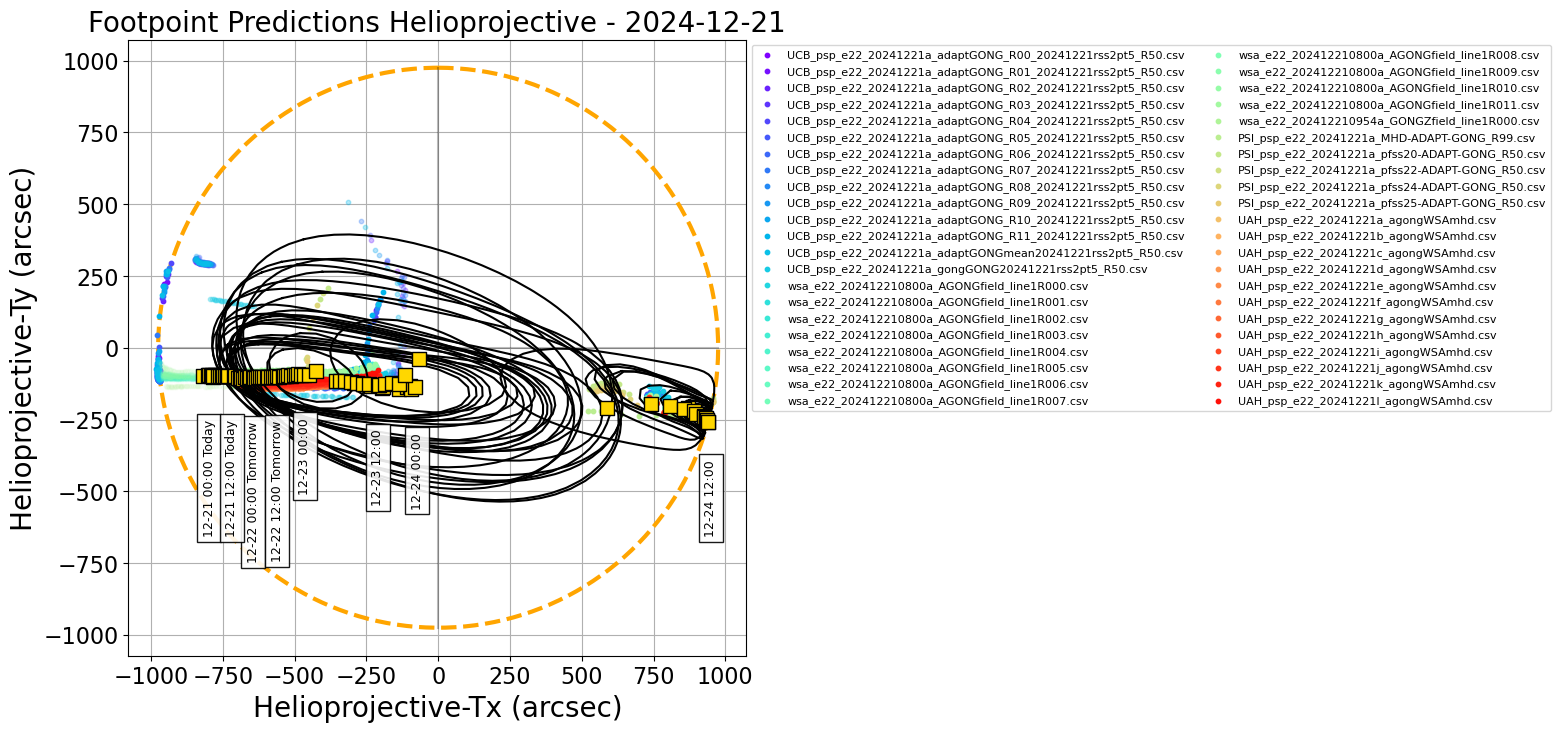
Figure 1.
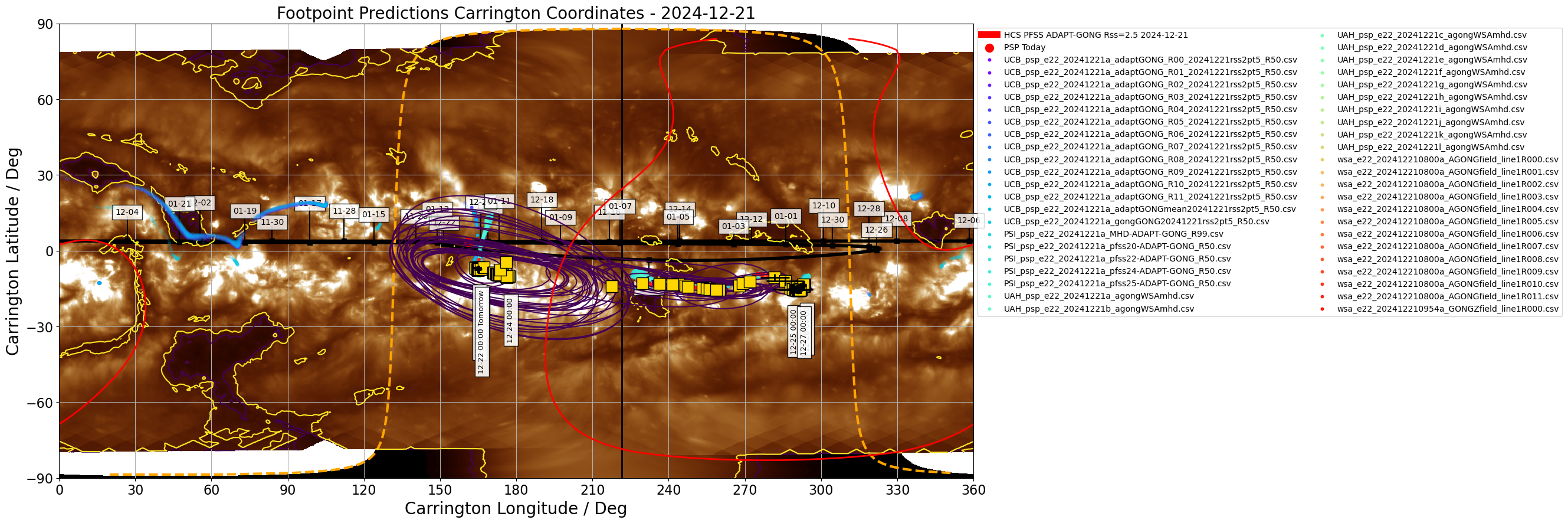
Figure 2.
Figures above show one footpoint per day plotted on the solar disk and in Carrington coordinates (click on figure to zoom and see caption).
The predicted footpoints were kindly provided by the PSP 20th Perihelion modeling team.
Encounter 22 Prediction update 1/4: 2024/12/21
------------------------------------------------
This is the first of four footpoint prediction issued for Parker Solar Probe Encounter 22, the first orbit to reach Parker's final record-breaking perihelion of 9.86Rs (occurring at 11:41 UT on December 24, 2024). This orbit's inbound phase connects to the visible disk and will rapidly cross the West limb just after perihelion. This means that during perihelion, the spacecraft will be located in the plane of the sky as seen from Earth (and also as seen from Solar Orbiter and STEREO A which are both located quite close in longitude to the Earth-L1 line of sight).
Magnetic Connectivity
---------------------
Footpoint predictions suggest most of the time in the leadup to perihelion, connection will remain tied to positive polarity open field in the vicinity of a near equatorial active region (AR 13932 and 13927). This connection persists until around midnight UT on 12/24 when the region will be at disk center. The prediction is then for the connection to jump dramatically to a negative polarity coronal hole just as it approaches the West limb (i.e. in just a couple of hours the connection is expected to jump from disk center to the limb). This coronal hole may be seen today in GOES SUVI 195A images (https://www.swpc.noaa.gov/products/goes-solar-ultraviolet-imager-suvi) just west of disk center. The connection is expected to travel behind the limb around Noon UT on 12/24.
Flare Likelihood (CCMC Flare Scoreboard)
----------------------------------------
As of 2024-12-21 at 00:00 UT, the CCMC Flare Scoreboard gave 24-hour average cumulative flare probabilities amounting at 87%, 22% and 1% for GOES C and above, M and above and X-class flares, respectively. This corresponds to a limited number of entries due to the known SDO data outage. A significant number of sunspot complexes currently appear on the visible disk, including NOAA ARs 13922 and 925-932.
From the CCMC CME Scoreboard, there is one active Earth-directed CME likely launched at 2024-12-20T21:27 UT (detected at 2024-12-20T23:23 UT) with an estimated speed of approx. 484 km/s from an apparent source location at N20E10, near the NOAA AR 13929 - 13931 complex. The predicted shock arrival at Earth-L1 is at approx. 2024-12-24T01:00 (+/- 7 hours) but is not expected to trigger a major geomagnetic event, with current projections calling for a below-minor to minor event. It is likely Parker will encounter the CME earlier and that it will interrupt the AR connection predicted above.
------------------
*** Note: In the attached file "*_HeliographicCarrington.png", the background image is a Carrington map courtesy of GOES/SUVI/195 A images, replacing the usual role of AIA 193/211 observations due to the JSOC data outage. Similarly, HMI-driven models are not available for this encounter. See the JSOC emergency page for details: https://solarweb1.stanford.edu/JSOC_Emergency_Resources.html
*** Please note that the "arrival time" and "emission time" and associated Tx/Ty coordinates for both are reported in the consensus CSV file. The attached plots show the "arrival time" (location of source at time that plasma will arrive at PSP). See https://docs.google.com/presentation/d/1mz02FU24vqKxxLRaJlyScfAh8gB07iOlBsTHApvhls8/edit#slide=id.p for some discussion on these***.
2024-12-22 (CSV, PDF table of coordinates)
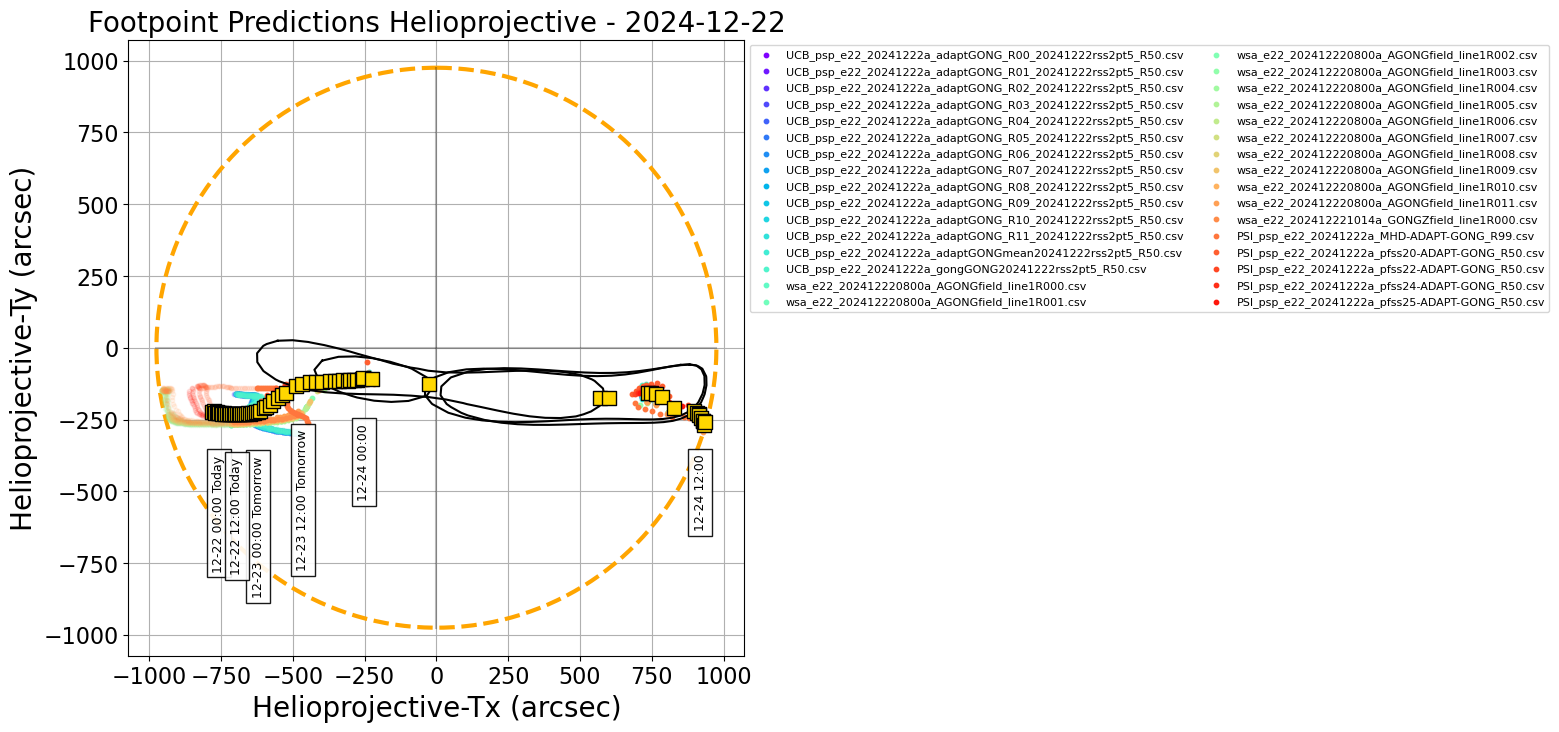
Figure 1.

Figure 2.
Figures above show one footpoint per day plotted on the solar disk and in Carrington coordinates (click on figure to zoom and see caption).
The predicted footpoints were kindly provided by the PSP 20th Perihelion modeling team.
Encounter 22 Prediction update 2/4: 2024/12/22
------------------------------------------------
This is the second of four footpoint predictions issued for Parker Solar Probe Encounter 22, the first orbit to reach Parker's final record-breaking perihelion of 9.86Rs (occurring at 11:41 UT on December 24, 2024). This orbit's inbound phase connects to the visible disk and will rapidly cross the West limb just after perihelion. This means that during perihelion, the spacecraft will be located in the plane of the sky as seen from Earth (and also as seen from Solar Orbiter and STEREO A which are both located quite close in longitude to the Earth-L1 line of sight).
Magnetic Connectivity
---------------------
Predictions remain stable from yesterday. Footpoint predictions suggest most of the time in the leadup to perihelion, connection will remain tied to positive polarity open field in the vicinity of a near equatorial active region (AR 13932 and 13927). This connection persists until around 0400 UT on 12/24 when the region will be at disk center. The prediction is then for the connection to jump dramatically to a negative polarity coronal hole just as it approaches the West limb (i.e. in just a couple of hours the connection is expected to jump from disk center to the limb). This coronal hole is still seen today in GOES SUVI 195A images (https://www.swpc.noaa.gov/products/goes-solar-ultraviolet-imager-suvi) west of disk center. The connection is expected to travel behind the limb around 2100 UT on 12/24 (somewhat later than yesterday's prediction).
Flare Likelihood (CCMC Flare Scoreboard)
----------------------------------------
As of 2024-12-22 at 00:00 UT, the CCMC Flare Scoreboard gave 24-hour average cumulative flare probabilities amounting to 100%, 40% and 7% for GOES C and above, M and above and X-class flares, respectively. This corresponds to a limited number of entries due to the known SDO data outage. A significant number of sunspot complexes currently appear on the visible disk, including NOAA ARs 13922 and 925-934.
From the CCMC CME Scoreboard, there is one active Earth-directed CME likely launched at 2024-12-20T21:27 UT (detected at 2024-12-20T23:23 UT) with an estimated speed of approx. 484 km/s from an apparent source location at N20E10, near the NOAA AR 13929 - 13931 complex. The predicted shock arrival at Earth-L1 is at approx. 2024-12-24T00:30 (+/- 7 hours) but is not expected to trigger a major geomagnetic event, with current projections calling for a below-minor to minor event. It is likely that Parker will encounter the CME earlier and that it will interrupt the AR connection predicted above.
------------------
*** Note: In the attached file "*_HeliographicCarrington.png", the background image is a Carrington map courtesy of GOES/SUVI/195 A images, replacing the usual role of AIA 193/211 observations due to the JSOC data outage. Similarly, HMI-driven models are not available for this encounter. See the JSOC emergency page for details: https://solarweb1.stanford.edu/JSOC_Emergency_Resources.html
*** Please note that the "arrival time" and "emission time" and associated Tx/Ty coordinates for both are reported in the consensus CSV file. The attached plots show the "arrival time" (location of source at time that plasma will arrive at PSP). See https://docs.google.com/presentation/d/1mz02FU24vqKxxLRaJlyScfAh8gB07iOlBsTHApvhls8/edit#slide=id.p for some discussion on these***.
2024-12-23 (CSV, PDF table of coordinates)
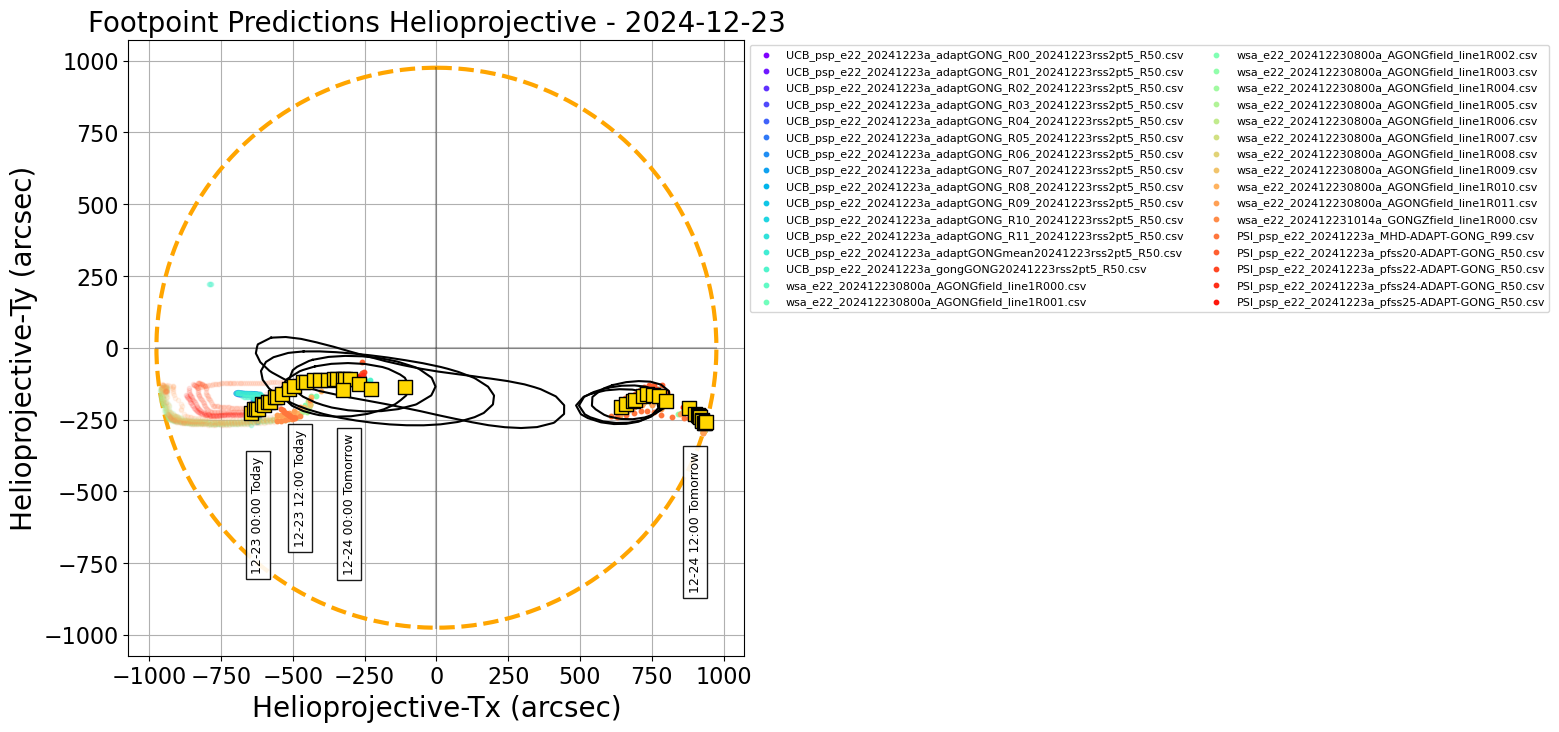
Figure 1.

Figure 2.
Figures above show one footpoint per day plotted on the solar disk and in Carrington coordinates (click on figure to zoom and see caption).
The predicted footpoints were kindly provided by the PSP 20th Perihelion modeling team.
Encounter 22 Prediction update 3/4: 2024/12/23
------------------------------------------------
This is the third of four footpoint predictions issued for Parker Solar Probe Encounter 22, the first orbit to reach Parker's final record-breaking perihelion of 9.86Rs (occurring at 11:53 UT on December 24, 2024, under 24 hours from now). This orbit's inbound phase connects to the visible disk and will rapidly cross the west limb just after perihelion. This means that during perihelion, the spacecraft will be located in the plane of the sky as seen from Earth (and also as seen from Solar Orbiter and STEREO-A which are both located quite close in longitude to the Earth-L1 line of sight).
Magnetic Connectivity
---------------------
Predictions remain stable from the first two updates. Footpoint predictions suggest the connection remains tied to a positive polarity open field in the vicinity of near-equatorial active regions (AR 13932 and 13927) until around 0300 UT on 12/24 when the region will be at disk center. The prediction is then for the connection to jump dramatically to a negative polarity coronal hole just as it approaches the west limb (i.e. in just a couple of hours the connection is expected to jump from disk center to the limb). This coronal hole is now seen approaching the west limb in GOES SUVI 195A images (https://www.swpc.noaa.gov/products/goes-solar-ultraviolet-imager-suvi). The connection is expected to travel behind the limb around 2200 UT on 12/24 (somewhat later than yesterday's prediction).
Flare Likelihood (CCMC Flare Scoreboard)
----------------------------------------
As of 2024-12-23 at 00:00 UT, the CCMC Flare Scoreboard gave 24-hour average cumulative flare probabilities amounting to 100%, 57% and 10% for GOES C and above, M and above and X-class flares, respectively, slightly elevated compared to yesterday’s prediction. A M9.0 flare occurred at 11:12 UT today. The current predictions correspond to a limited number of entries due to the known SDO data outage. A significant number of sunspot complexes currently appear on the visible disk, including NOAA ARs 10925 - 10935.
From the CCMC CME Scoreboard, as in yesterday’s update, there is one active Earth-directed CME likely launched at 2024-12-20T21:27 UT (detected at 2024-12-20T23:23 UT) with an estimated speed of approx. 484 km/s from an apparent source location at N20E10, near the NOAA AR 13929 - 13931 complex. The predicted shock arrival at Earth-L1 is at approx. 2024-12-24T00:30 (+/- 7 hours) but is not expected to trigger a major geomagnetic event, with current projections calling for a below-minor to minor event. It is likely that Parker will encounter the CME earlier and that it will interrupt the AR connection predicted above.
------------------
*** Note: In the attached file "*_HeliographicCarrington.png", the background image is a Carrington map courtesy of GOES/SUVI/195 A images, replacing the usual role of AIA 193/211 observations due to the JSOC data outage. Similarly, HMI-driven models are not available for this encounter. See the JSOC emergency page for details: https://solarweb1.stanford.edu/JSOC_Emergency_Resources.html
*** Please note that the "arrival time" and "emission time" and associated Tx/Ty coordinates for both are reported in the consensus CSV file. The attached plots show the "arrival time" (location of source at time that plasma will arrive at PSP). See https://docs.google.com/presentation/d/1mz02FU24vqKxxLRaJlyScfAh8gB07iOlBsTHApvhls8/edit#slide=id.p for some discussion on these***.
2024-12-24 (CSV, PDF table of coordinates)
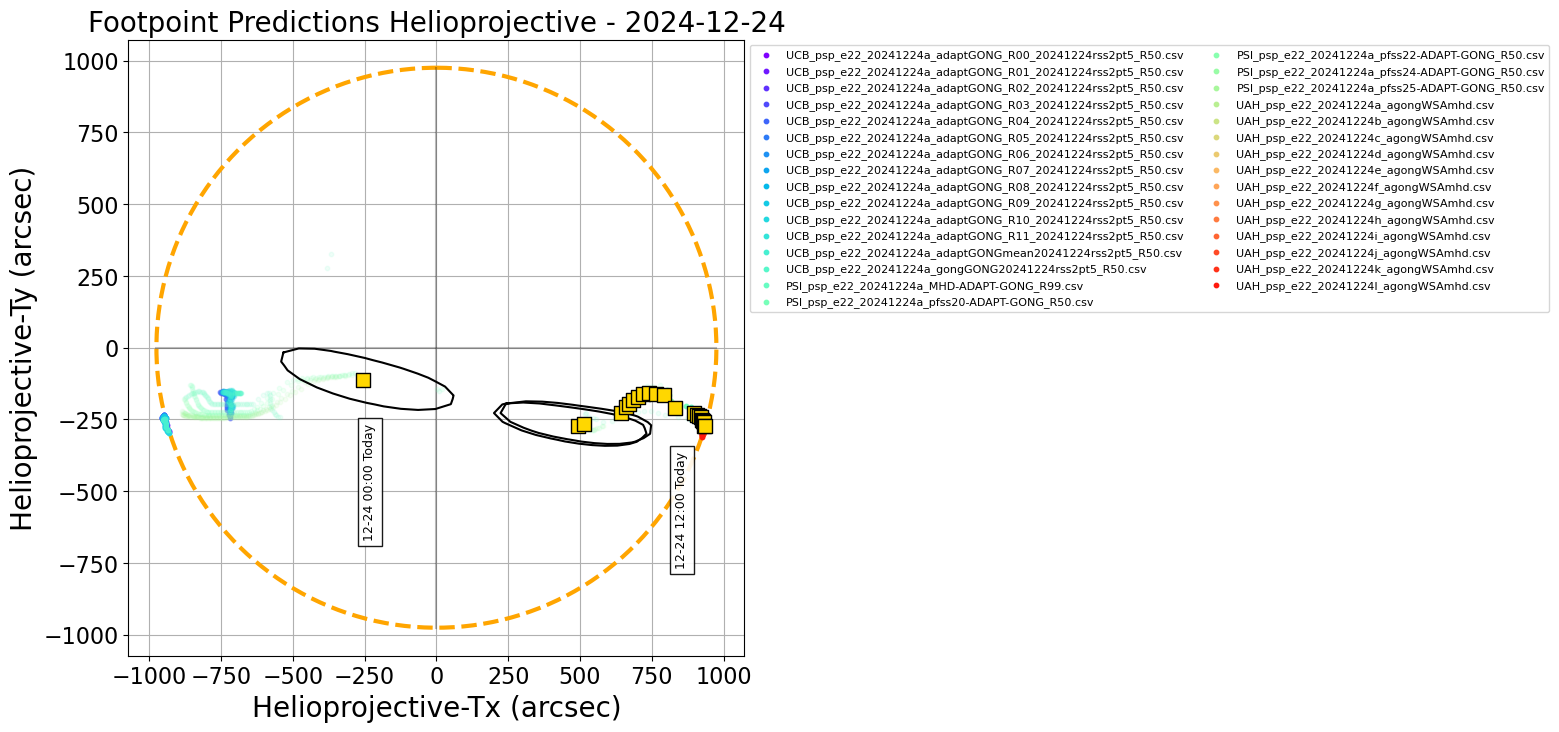
Figure 1.

Figure 2.
Figures above show one footpoint per day plotted on the solar disk and in Carrington coordinates (click on figure to zoom and see caption).
The predicted footpoints were kindly provided by the PSP 20th Perihelion modeling team.
Encounter 22 Prediction update 4/4: 2024/12/24
------------------------------------------------
This is the final of four footpoint predictions issued for Parker Solar Probe Encounter 22, the first orbit to reach Parker's final record-breaking perihelion of 9.86Rs which occurred earlier today at 11:53 UT (6:53 ET). This orbit's inbound phase connected to the visible disk and today briefly skirts the West limb before disappearing from sight. The spacecraft will shortly be located in the plane of the sky as seen from Earth (and also as seen from Solar Orbiter and STEREO-A which are both located quite close in longitude to the Earth-L1 line of sight).
Magnetic Connectivity
---------------------
The prediction has jumped dramatically to a negative polarity coronal hole just as it approaches the west limb, seen in GOES SUVI 195A images (https://www.swpc.noaa.gov/products/goes-solar-ultraviolet-imager-suvi). The connection is only brief and is expected to travel behind the limb around 2200 UT today. For the hours prior and after this, Parker will be located 5 solar diameters above the West limb as seen from Earth.
Flare Likelihood (CCMC Flare Scoreboard)
----------------------------------------
As of 2024-12-24 at 00:00 UT, the CCMC Flare Scoreboard gave 24-hour average cumulative flare probabilities amounting to 100%, 59% and 16% for GOES C and above, M and above and X-class flares, respectively, further elevated compared to yesterday’s prediction. Three M-class flares have so far occurred today. The current predictions correspond to a limited number of entries due to the known SDO data outage. An even larger, very significant number of sunspot complexes currently appear on the visible disk, including NOAA ARs 10925 - 10937.
From the CCMC CME Scoreboard, there is an active Earth-directed CME likely launched at approx. 2024-12-23T11:00 UT (detected at 2024-12-23T11:36 UT) with an estimated speed of approx. 823 km/s. It is possibly related to the M9.0 flare at 11:12 UT on 2024-12-23 from NOAA AR 10932 but is possibly overlapping, albeit unrelated, to a farside event. The predicted average shock arrival time at Earth is 2024-12-25T16:50 (+/- 5 hours). The expected Kp-index at Earth is between 5 and 7 in most predictions, calling for a geomagnetic event in the range minor – moderate – strong. It is likely that Parker encountered or flew behind this CME earlier in the encounter.
------------------
*** Note: In the attached file "*_HeliographicCarrington.png", the background image is a Carrington map courtesy of GOES/SUVI/195 A images, replacing the usual role of AIA 193/211 observations due to the JSOC data outage. Similarly, HMI-driven models are not available for this encounter. See the JSOC emergency page for details: https://solarweb1.stanford.edu/JSOC_Emergency_Resources.html
*** Please note that the "arrival time" and "emission time" and associated Tx/Ty coordinates for both are reported in the consensus CSV file. The attached plots show the "arrival time" (location of source at time that plasma will arrive at PSP). See https://docs.google.com/presentation/d/1mz02FU24vqKxxLRaJlyScfAh8gB07iOlBsTHApvhls8/edit#slide=id.p for a discussion on these***.
Date and arrival time of plasma parcel at PSP, consensus carrington longitude (deg), latitude (deg), error in longitude, error in latitude, on-disk position of predicted source in X and Y (arcseconds) at arrival time, date and emission time of plasma parcel at the source, on-disk position of predicted source at time parcel is emitted. Each row is the updated source location each hour.
The consensus is generated by forming a distribution of footpoint predictions from all modelers for each hour period, and attempting to fit a Kent distribution. If the fitting fails, the median in longitude and latitude are quoted. If the fitting is successful, the quoted errors are formed by drawing random samples from the fitted distribution and computing the standard deviation in longitude and latitude of those samples. If the fitting fails, the quoted errors are the standard deviation in the longitude and latitude from the raw distribution of predictions. The full shape of the distribution is described by black contours in the associated plots on this website. More details about the procedure can be found at the following preprint of Badman et al. (2023) "Prediction and Verification of Parker Solar Probe Solar Wind Sources at 13.3Rs"
Please note the carrington coordinates (lon,lat) are valid from the quoted timestamp (in UTC) until the next timestamp. The helioprojective coordinates quoted (HP-Tx, HP-Ty) are computed from the carrington coordinate at the quoted timestamp (e.g. midnight UTC each day) and so are valid instantaneously at this time but will corotate with the Sun until the next quoted timestamp. For a discussion of the subtle difference in emission and arrival time and why both are included please see the slide deck.
Individual model prediction tables of coordinates may be found in a Public DropBox. Files in the Public DropBox have three-letter identifiers indicating the associated model (see below).
Three-letter designation for Public DropBox: UCB. Kindly provided by Sam Badman. The model is a simple ballistic propagation from PSP down to the source surface assuming slow wind 360km/s, and then tracing this sub-PSP trajectory through a PFSS model to get footpoints at the photosphere. The source surface height here is 2.5Rs. The PFSS model is generated using various ADAPT maps with GONG and HMI as input, and the model is run using the open source pfsspy package. A more detailed explanation of the model and comparison to PSP E1 results are given here.
Three-letter designation for Public DropBox: PSI. Kindly provided by Pete Riley. For these predictions, PSI is using a combination of modeling approaches, including PFSS solutions, empirically-based polytropic MHD solutions, and a more sophisticated approach that includes the effects of waves and turbulence to heat the corona and the WKB approximation for wave pressures to accelerate the solar wind. Additionally, boundary conditions are derived from both HMI and ADAPT synoptic magnetograms. Together, these allow us to generate a rich set of ensemble realizations from which to make our optimal prediction, as well as pool them with other teams’ forecasts to derive a hyper-ensemble prediction.
Three-letter designation for Public DropBox: wsa. Kindly provided by Shaela Jones. The Wang-Sheeley-Arge (WSA) model is a combined empirical and physics-based model of the corona and solar wind. The coronal portion of the Wang-Sheeley-Arge (WSA) model is comprised of the Potential Field Source Surface (PFSS) and Schatten Current Sheet (SCS) models, where the output of the PFSS model serves as input to the SCS model. The solar wind portion of WSA consists of a simple 1-D kinematic propagation code that takes stream interactions into account in an ad-hoc fashion. It provides predictions of the solar wind speed and interplanetary magnetic field IMF polarity at any specified point in the inner heliosphere. The WSA model can use global maps of the photospheric magnetic flux measurements from a number of sources as its inner boundary condition; here we are using an ensemble of maps from the Air Force Data Assimilative Photospheric Flux Transport (ADAPT) model, based on input GONG magnetograms.
UAH predictions come from the University of Alabama, Huntsville Multiscale Fluid-Kinetic Simulation Suite (MS-FLUKSS, Pogorelov et al. (2014); Pogorelov (2023); Singh et al. (2022)), which can solve the Reynolds-averaged ideal MHD equations for the mixture of thermal and nonthermal solar wind ions coupled with the kinetic Boltzmann equation describing the transport of neutral atoms. An adaptive mesh refinement technique can be employed for efficient high-resolution calculations. The MS-FLUKSS heliospheric MHD model is coupled with the WSA model (Kim et al., 2020), which uses both ADAPT-GONG and ADAPT-HMI input magnetograms, with the PFSS source surface height and the WSA outer boundary at 2.5 and 10 solar radii, respectively. Hence, field line tracing is performed through the MHD domain down to 10 solar radii instantaneously at approximately 1 hour cadence, where the origin of the field line on the photosphere is already known, as described for WSA.
see Prediction and Verification of Parker Solar Probe Solar Wind Sources at 13.3Rs, Badman et al. (2023)